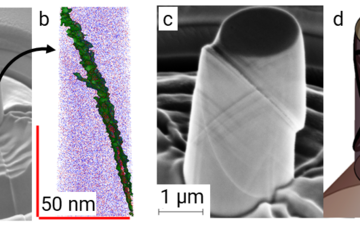All genres
21.
Talk
Neues Licht aus künstlichen Atomen - Halbleiterquantenpunkte. Schulvortrag zur Jahrestagung der MPG, Dresden, Germany (2008)
22.
Talk
Optical properties of semiconductor nanostructures including strain and piezoelectric effects. PARSEM meeting and workshop, Cambridge, UK (2008)
23.
Talk
Plane-wave implementation of the k.p-formalism including strain and piezoelectricity to study the optical properties of semiconductor nanostructures. Spring meeting of the German Physical Society (DPG), Berlin, Germany (2008)
24.
Talk
Optical properties of semiconductor nanostructures, a PW-approach to real-space properties. MRL seminar at UCSB, UCSB, Santa Barbara, USA (2008)
25.
Talk
A plane-wave approach to real-space properties of semiconductor nanostructures: Electronic states, strain profiles and piezoelectric fields. PAW workshop 2007, Goslar, Germany (2007)
26.
Talk
Application of the 8-band k.p-formalism to semiconductor nanostructures. Forschergruppentreffen Uni Bremen, Bremen, Germany (2007)
27.
Talk
Department of Computational Materials Design: Present activities and future research. Guided tour in the MPIE of IMPRS-SurMat, Duesseldorf, Germany (2007)
28.
Talk
Implementation and application of the k.p-formalism to electronic structure and Coulomb matrix elements. Spring meeting of the German Physical Society (DPG), Regensburg, Germany (2007)
29.
Talk
Implementation and application of a multi-scale approach to electronic properties of group III-nitride based semiconductor nanostructures. Workshop on Nitride Based Nanostructures, Berlin, Germany (2007)
30.
Talk
A k.p approach to electronic states and Coulomb interaction in semiconductor quantum dots. Forschergruppentreffen Uni Bremen, Bremen, Germany (2007)
31.
Talk
Optical properties of semiconductor quantum dots and wires. EW3NS, Heraklion, Kreta (2006)
32.
Talk
An envelope potential approach to semiconductor quantum dots. Seminar at Institut für Theoretische Physik, Universität Bremen, Germany (2006)
33.
Poster
Shape effects of semiconductor quantum dots on the optical spectra. ADIS 2006, Ringberg Castle, Germany (2006)
34.
Thesis - PhD
Implementation and application of continuum elasticity theory and a k.p-model to investigate optoelectronic properties of semiconductor nanostructures. Dissertation, University of Paderborn, Paderborn, Germany (2010)











